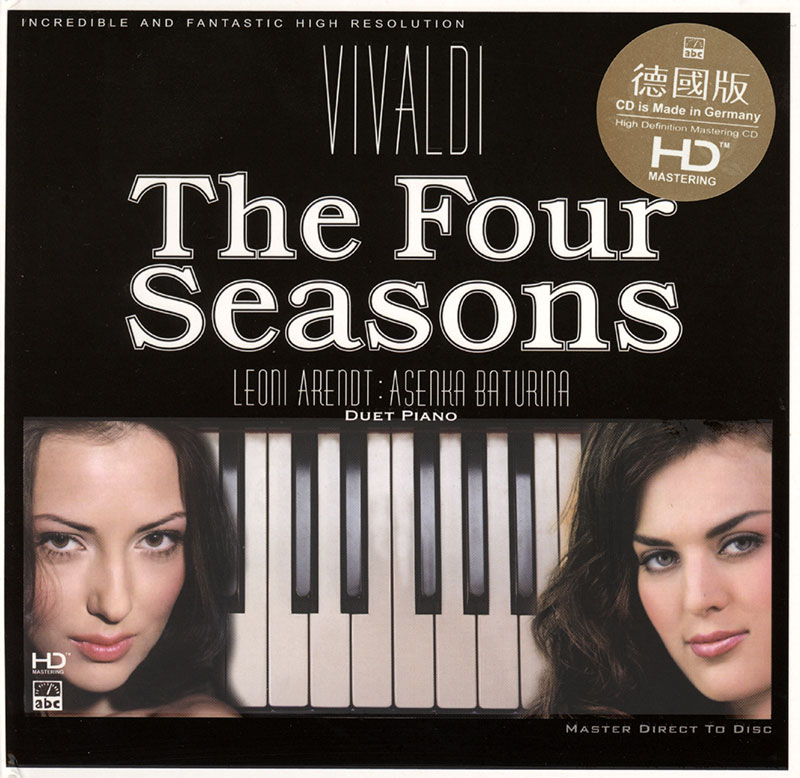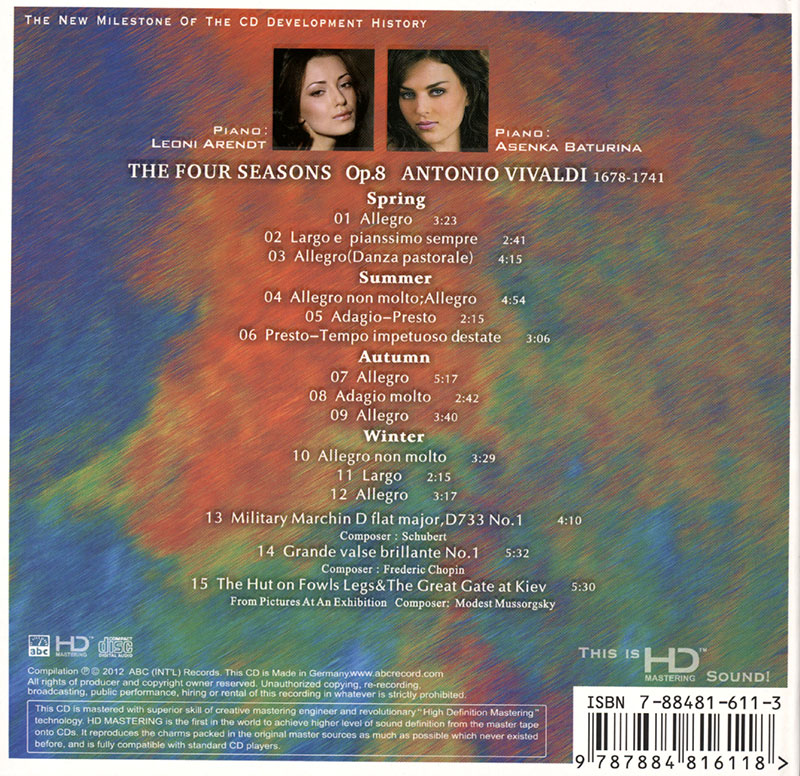Logowanie
Mikołaj - ten to ma gest!
Elton John, The Mamas & The Papas, Cat Stevens, Rod Stewart, Bobbie Gentry, Stevie Wonder, Engelbert Humperdinck
Memory Lane
Edycja Numerowana - 1000 egzemplarzy w skali światowej
RACHMANINOV, Eiji Oue, Minnesota Orchestra
Symphonic Dances / Vocalise
Best Recordings of 2001!!! NAJCZĘŚCIEJ KUPOWANA PŁYTA Z RR!
Karnawał czas zacząć!
Music of Love - Hi-Fi Latin Rhythms
Samba : Music of Celebration
AUDIOPHILE 24BIT RECORDING AND MASTERING
CHOPIN, LISZT, DEBUSSY, DVORAK, Gerhard Oppitz
Dances romantiques - A fantastic Notturno
Wzorcowa jakość audiofilska z Clearaudio
Winylowy niezbędnik
ClearAudio
Double Matrix Professional - Sonic
najbardziej inteligentna i skuteczna pralka do płyt winylowych wszelkiego typu - całkowicie automatyczna
VIVALDI, Leoni Arendt, Asenka Baturina
The Four Seasons - Duet Piano

- Leoni Arendt - piano
- Asenka Baturina - piano
- VIVALDI
AAD is a Digital Copy Of
The Master Tape
Vivaldi Violin Concertos as two-piano music? “The Four Seasons” played, not on a set of strings built in 1722 by orphaned nuns on a small Venetian island, but on a pair of modern concert grands! Until recently, “arrangements” were a simple fact of musical life. They still are in almost every area of music—except “classical”. The notion of authenticity and the prejudice against transcriptions is a modern idea. It is a connoisseur’s and critic’s view of an ancient culture, not a characteristic of living musical art. Liszt and Busoni transcribed Bach. So did Schoenberg, Webern and Stravinsky. Bach himself was a relentless transciber and his favorite transcribe was Vivaldi. Like Almeida Prado, Bach transcribed Vivaldi Violin Concertos for keyboard. Bach never transcribed “The Seasons”---then, as now, the composer’s most famous and popular compostitions. But he didn’t have to: it was transcribed over and over again from the 1730s on. Jean Jacques Rousseau arranged “La Primavera” in 1755 for solo flute! It was also transcribed for (among other things) musette, hurdy-gurdy and large chorus! When the piano began to dominate the musical scene at the end of the eighteenth century, it quickly became the focus for arrangements and transcriptions. Almost every major orchestral, ensemble of operatic work appeared in keyboard versions---for one piano, two hands, one piano, four hands or two pianos; for duffers as well as virtuosi. The piano, not the orchestra, became the major means for the transmittal of classical and romantic musical culture and eventually the transcribers also went back to Baroque. What is authenticity in baroque music? In many ways, baroque music is more like jazz than like the classical and romantic music that followed. It is rhythm-section music, based on the use of keyboards and a strong bass. The continuo or rhythm instruments give strong, steady rhythm tracks and fill the fundamental chords or change. Over the continuo or rhythm tracks, the band arrangement appears---strings in the baroque, winds and brass in jazz and soloists in both. Arrangements or adaptations of existing music, sometimes highly reelaborated, are to be expected. A certain amount of player elaboration and even improvisation is permitted or even desired. Keyboard versions of the most polular pieces are widely performed and published. The issue of transcriptions has already been mentioned. Another is the notion of the “imitation of nature”. The love and appreciation of nature is itself a product of the early eighteenth-century and so is the idea that man has departed too far from his original state of nature by over-civilizing himself. Jean-Jacques Rousseau, himself a musician and composer (and, as we have seen, arranger of “La Primavera”), was a strong exponent of these ideas which he diffused all over Europe through his writings in the famous Encyclopedie for which he wrote the articles on music. Rousseau opposed “pure” music and argued that good music always “imitates nature”---including emotions and states of mind as well as thunderstorms and bird songs. He also argued that French music was too artificial and too “civilized” while Italian music, simpler, more “natural”, more engaged in both feelings and scene painting, was far superior. Vivaldi’s work is, in many ways, a perfect realization of Rousseau’s theories. Although still classified as baroque, it is simpler in texture and less contrapuntal than its predecessors---on the way to rococo and classical. It uses the most direct means to evoke moods and pictures----the “imitation”, so much talked about by the Enlightenment estheticians. Vivaldi prefaced each of the concerto of Le quattro stagioni with a sonnet, probably written by the composer himself of a close collaborator. These lines are actually keyed out to specific passages of music indicating precisely what Vivaldi intended to illustrate. A new translation of these sonnets is given below---partly because they ought to be better known, partly becausePrado refers to them in his transcription, partly because the quaint old Italian has been often mistranscribed and mistranslated, and partly because the literalness of the program does not accord very well with our conventional and mistaken notions about baroque music.





























